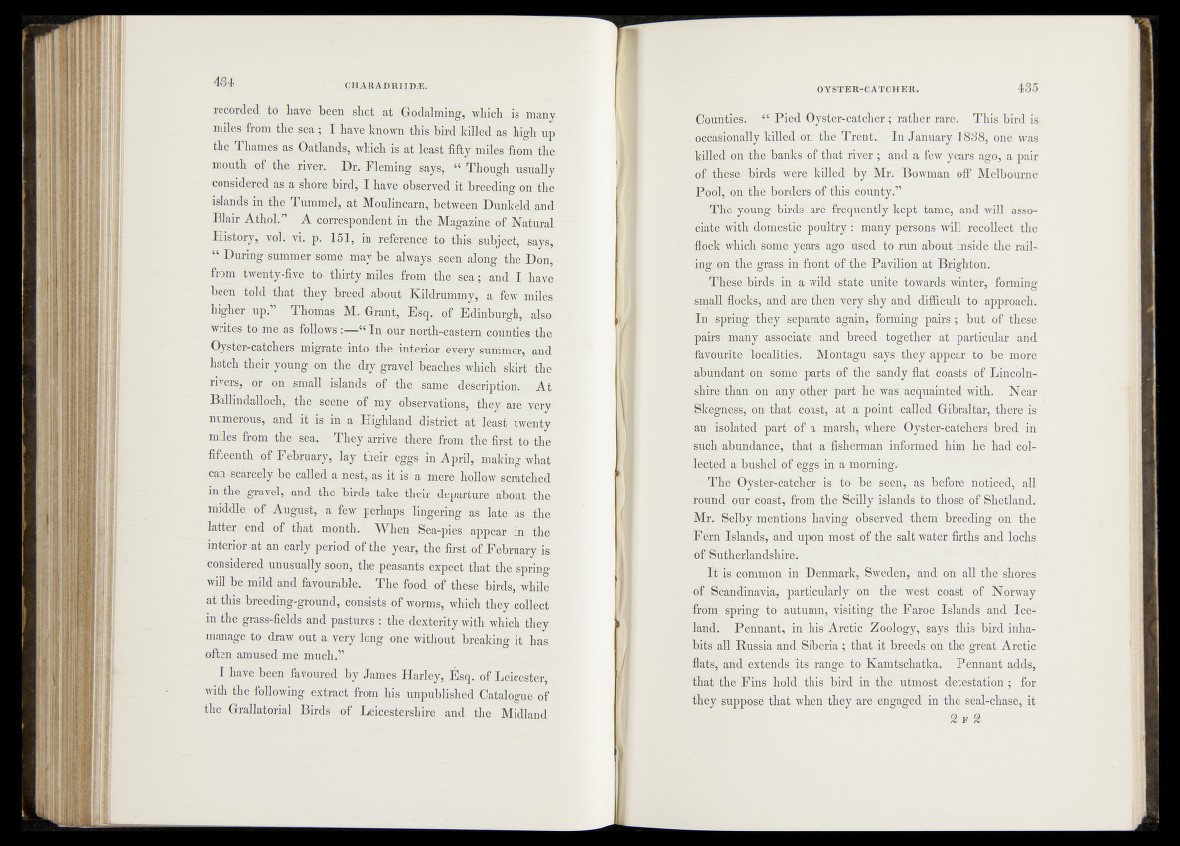
recorded to have been shot at ; Godaiming, which.,is many
miles from the sea; I have known this bird killed as high np
the Thames as Oatlands, which is at least fifty miles from the!
mouth of the river. Dr. Fleming says, Though usually*
considered as a shore bird, I have observed it breeding on the?
islands in the Tumrael, at Moulincarn, between Dunk eld jmd
Blair Athol. 1 A correspondent in the Magazine of ^Natural
History, vol. vi. p,; 151, in reference to this subject;, says,
1 During summer some may be always seen along the Don,
frmri twenty-five to thirty miles from the sea; and I have
been told that they breed about Kildrummy, a few miles
higher up.” Thomas M. Grant, Esq. of Edinburgh, „also
writes to me as f o l l o w s “ In our north-eastern cqunties/th-e-
Oysterrcatchers, ^migrate into therinterior every summjeir, and
hatch their young on the dry gravel beaches which skirt the.
rivers, or on..small islands of the same description*. At
Ballindalloch,: the scene of my observations,; they are very
numerous, and it is in' a Highland district, a t|$ i^ t twenty
miles from the-sea. They arrive there from the first; to the;
fifteenth of February, lay theiipëgg« in April, making what
can ^arcely be called a nest, as it is a jnere holldwvseratch^|
in the gravel, and thé birds take their departure aboiftjtke
middle of August, a few perhaps lingering as late as the
latter end of that month. . When Sea-pies appear -in. the
interior at an early period of the year, 'theAfir^ |6£Februajry;is.
considered unusually soon, the peasants expect that the spring
will be. mild and favourable. The food of these, birds, :while
at this breeding-ground, consists of worms, which they!,c§eot?
in the grass-fields and pastures : the dexterity with which %ey
manage to draw out a very long one-without ..breaking it ..has
often amused me much.” -
I havé been favoured by James Harley, Esq. of Leicester,,
with the. following extract from, his unpublished Catalogue, of
the Grallatqrial Birds of Leicestershire and the Midland
Counties.. “ Pied’.Oyster-catcher; rather rare. This bird is
occasionally killed on1 the Trent. In January 1838, one was
killed on the banks of.that river ; and a few years ago, a pair
of these birds were tfil'lhtfl by- Mr. Bowman off Melbourne
P § ' on the borders of -this county.”
T ie young birds are frequently kept tame, and will- associate
with domestic poultry : many persons will recollect the
flock which sdme/years ‘ago :useft$ to run about inside the ra il-?
itig,on the grass in p lu ^ o f the PifaftfOmalt Brighten;
Thes&birds 'in a* wif^state unite towards winter, forming
ShjaM flocks, and aru^hen-v6^ k h J ^ iknd‘i;at® ult, tp approach.
In spring thef; separate; again|?fforming 'pairs ; but of "these
pairs/many af^pciafe^ and’ bre6d! tro'gcther ’at particular and
favourit§fdbcalitms| JVIontagq say^hhfytappdar^to be mo're4
abundant < jhi-scfihb^ parts ^J^'l^^afrfly flat coasts of Lincoln^
shire Iplan on any other part he was acquainted with. JfeaT
fehegmfss, oil that coast|f^i| a pointe called Gibrait&i*; there1 is
an is’Ola|ed pafWof a marsh, wlrafci ()ys^^patcher£ bred' in
suehvabu'iidah|e,1 thafra^fefietmaii infamiedr him he? had eol-
fMft-cd adhrsm'PofjctggS ih a i n o l m ^
r The f)yster-Catch e r' is to' ? \m\ bhfofe^notifed, all
M ind our chfe^frOm the Scilly islands to those of Sh'etland.j
Mri^Selby mehti'p'ii'S having §mSel:ved- thehfi;b*reh®rig!* bn the
Fern ^Islands, 'aridSpofriiliitr of the Salt-water firths and loch#
ofMltherlandshirh;* vs
It fs -common i®. DenMafk,; Sweden^ -afidlon all the shores
Scandinavia, particularly ’ 'on tHepWest' coast3'- ;ofhNorway
from opting to aUtumh'f5f|sa.|tiig the Faroe Islands aiid Ice-'
land. PenifaUt, in his' *Afrt& Zoology, says' this'bird inhabit#
all Russia aridHBiberiajt that ft breeds on 'the' great Arctic
flats, and- extends;its range’ito Kamtschatka. Pennant adds,
that the Fins hold this bird in theutiftost' detestation ; for
they suppose that when they are engaged in the seal-chase, it
■ 2